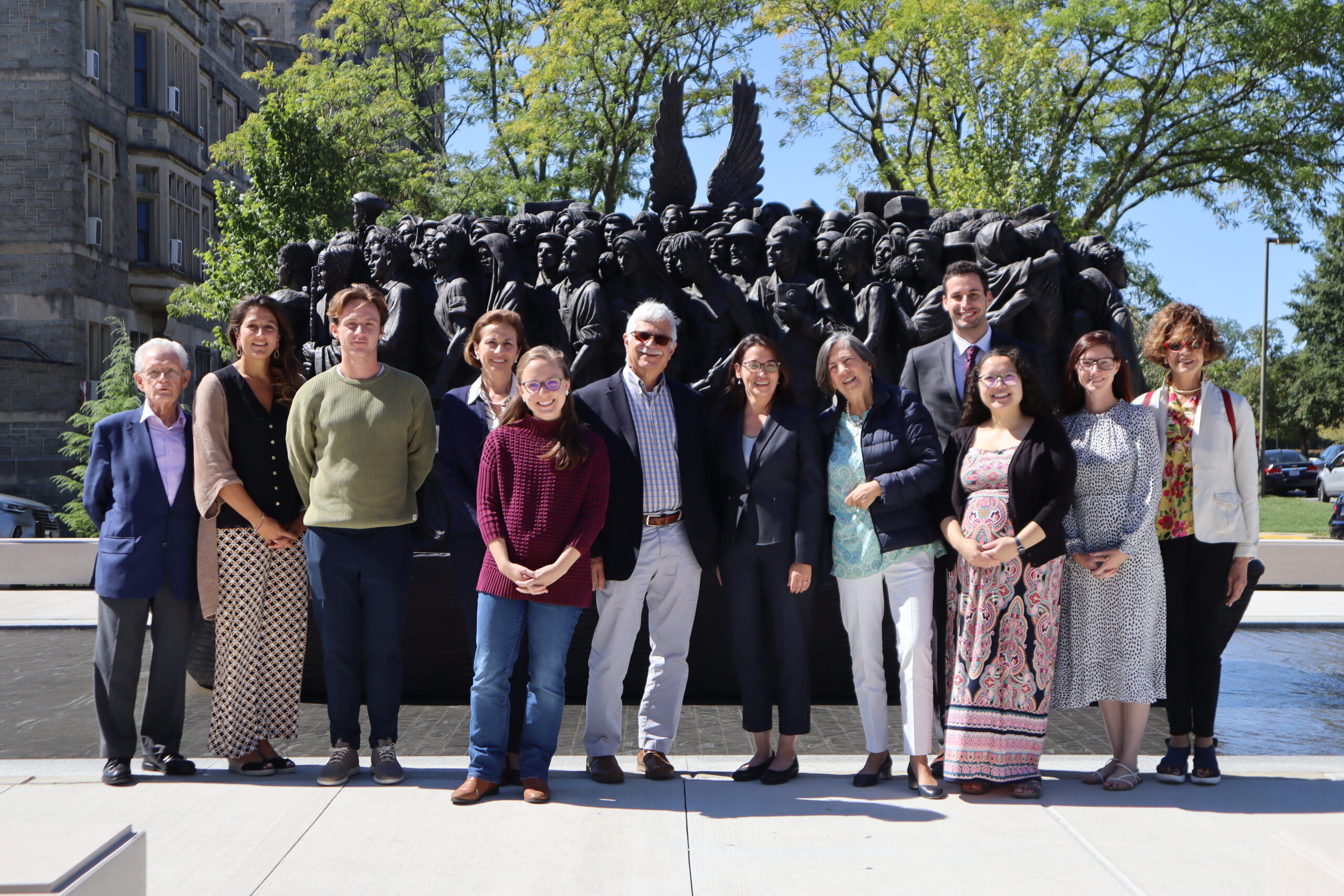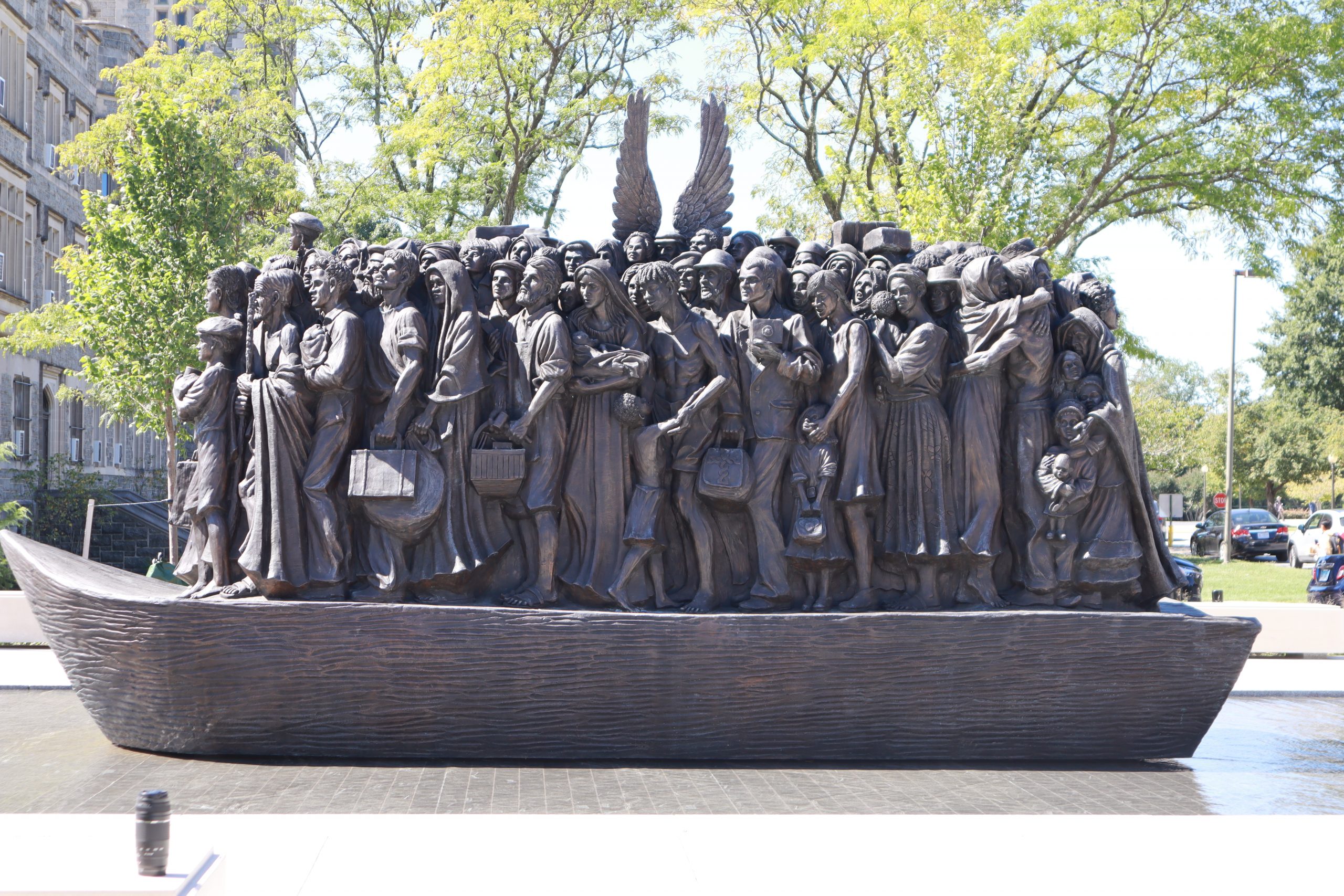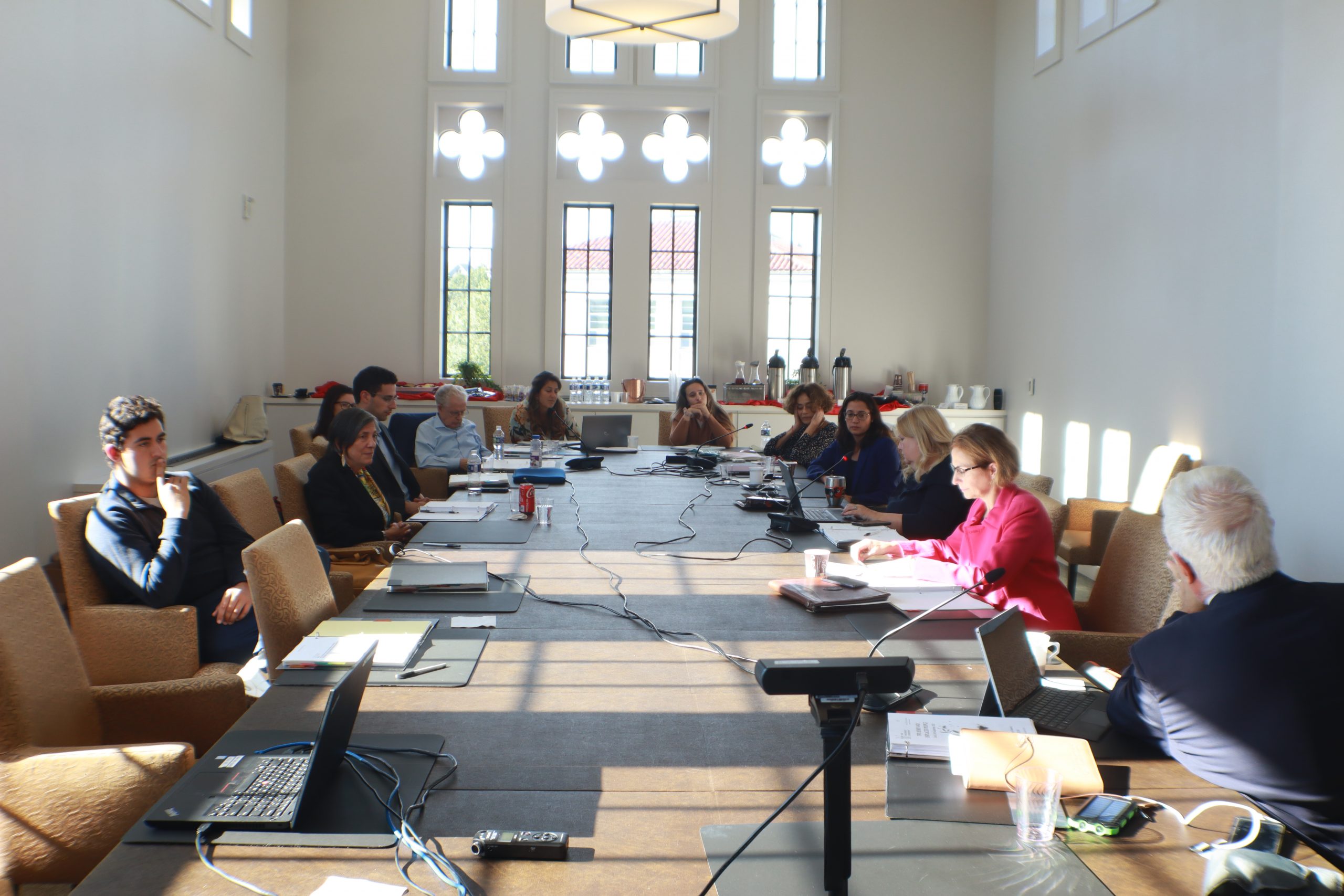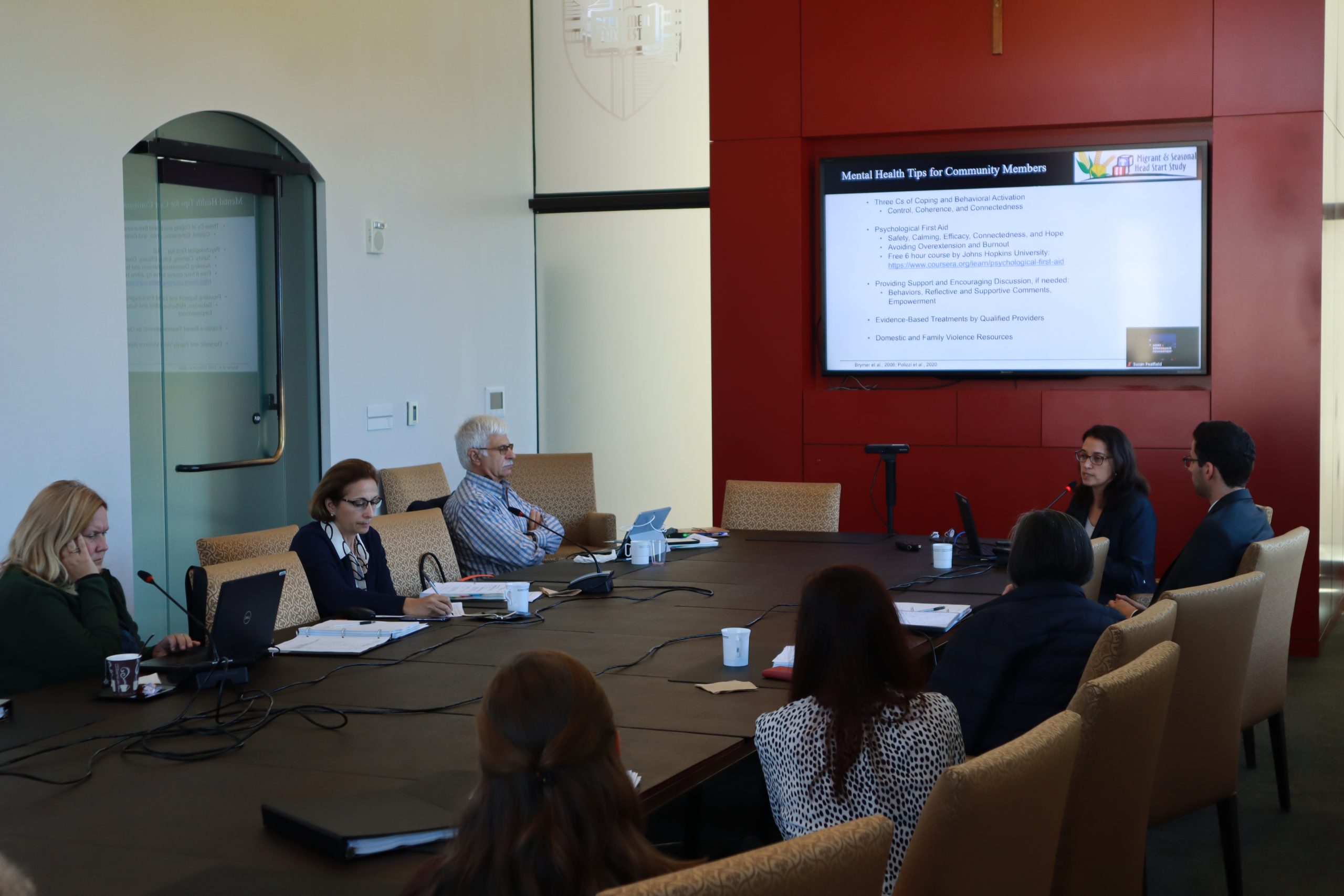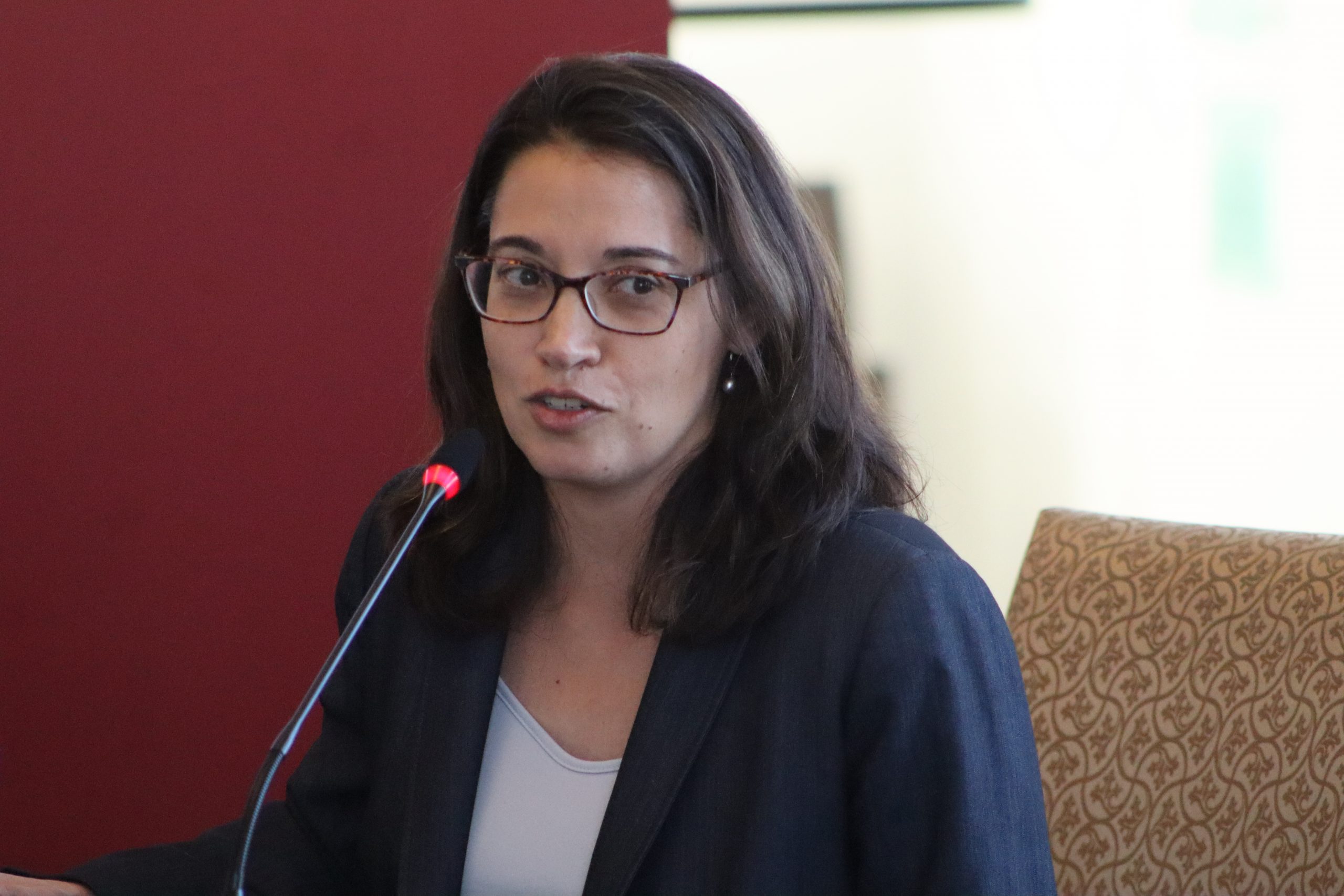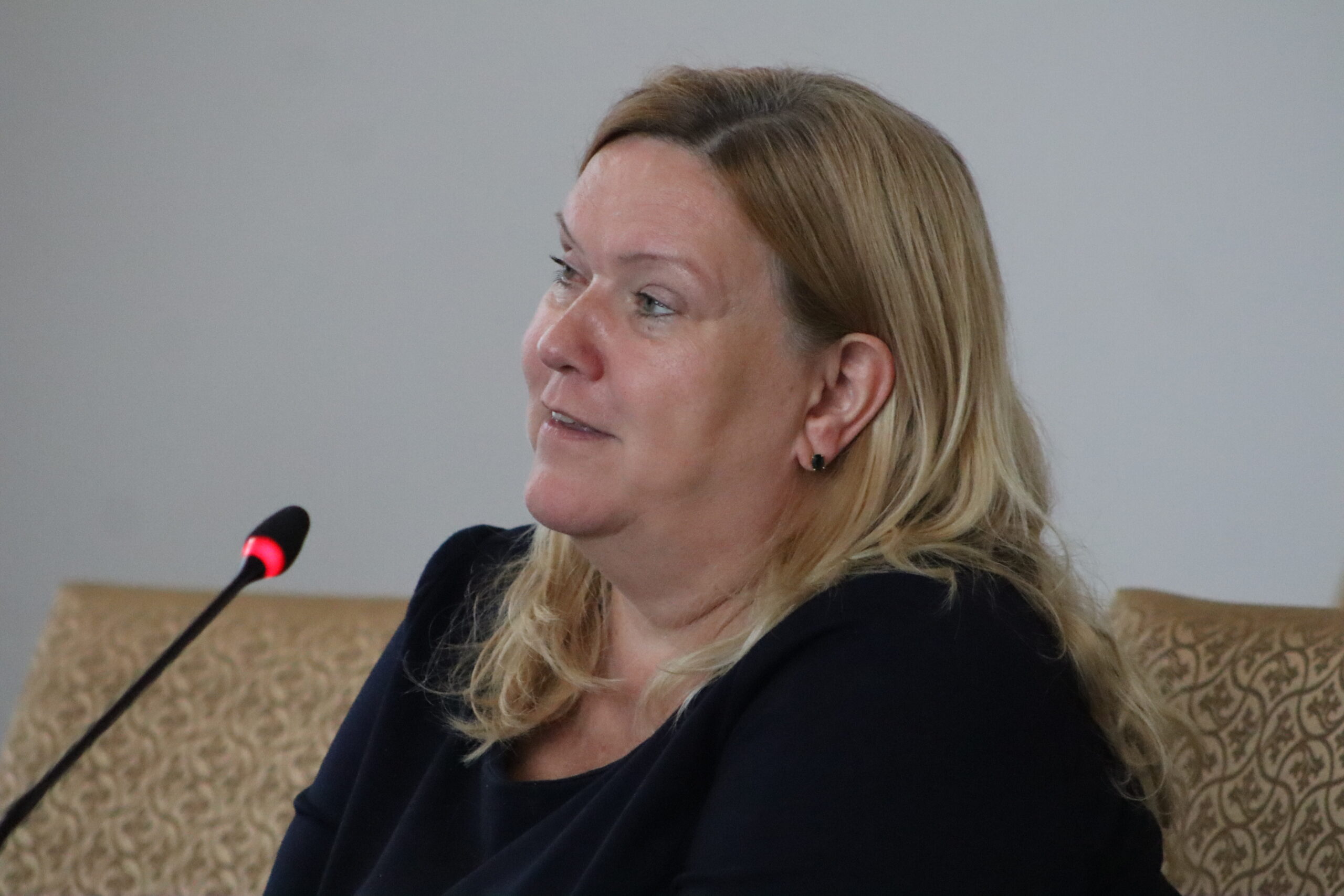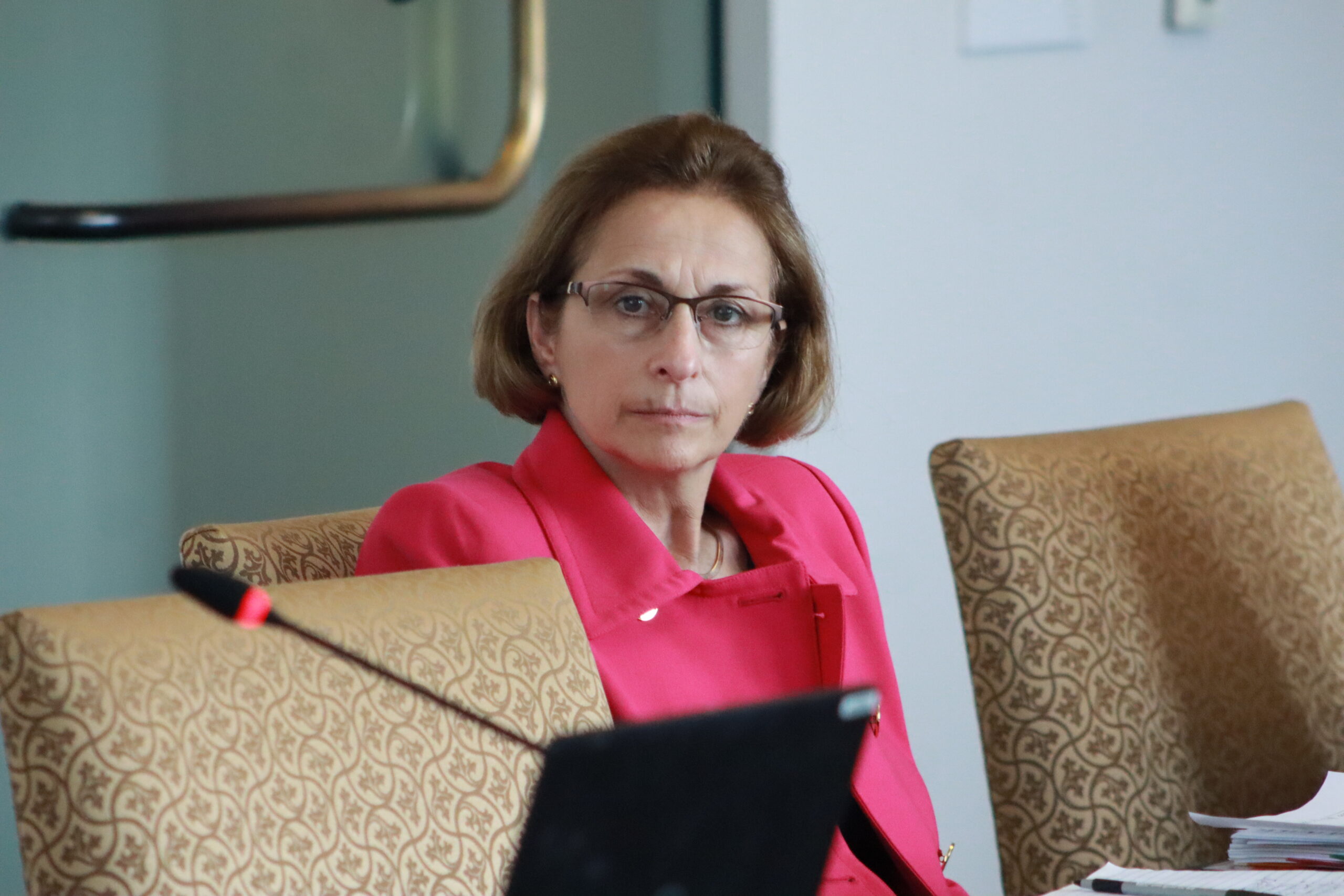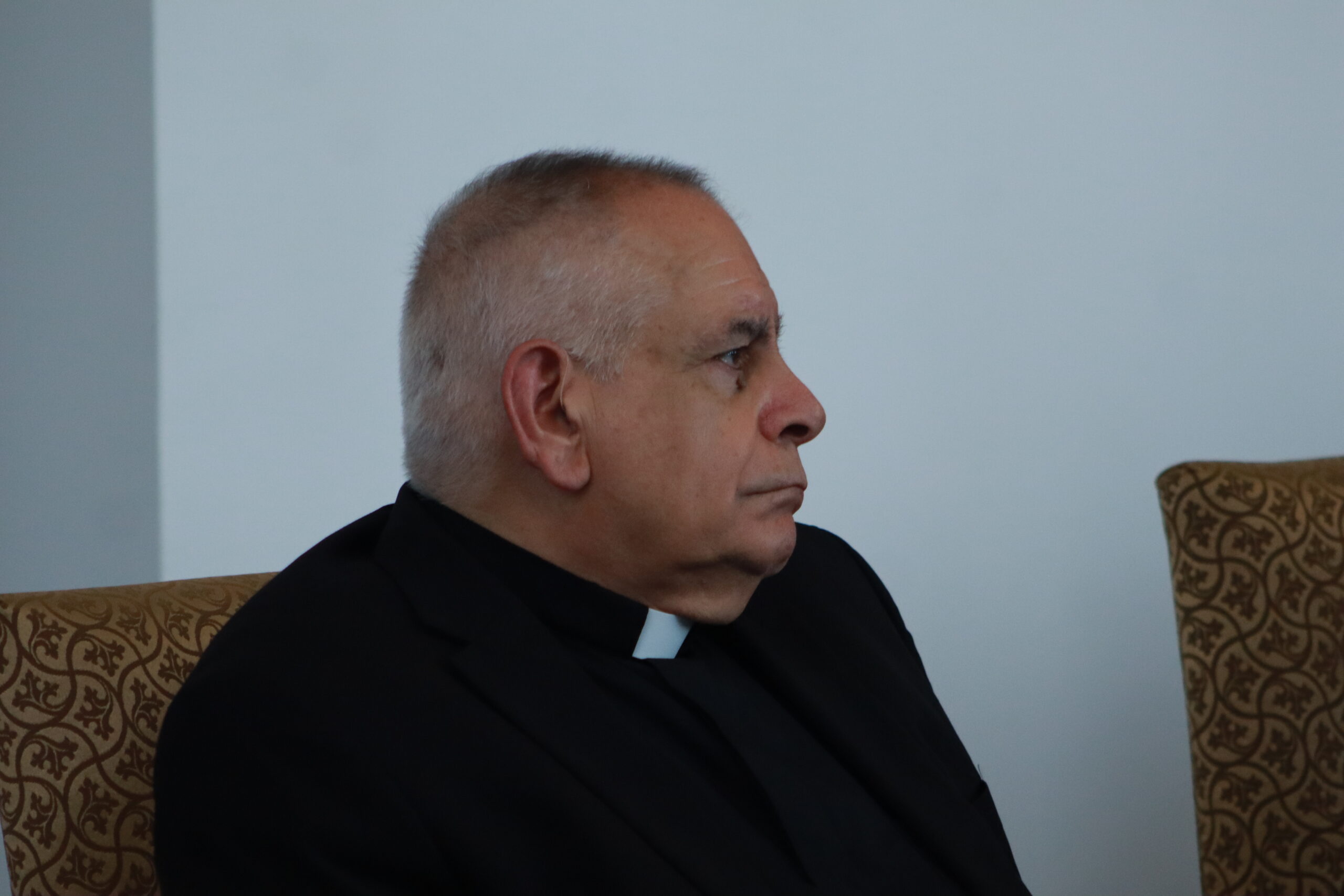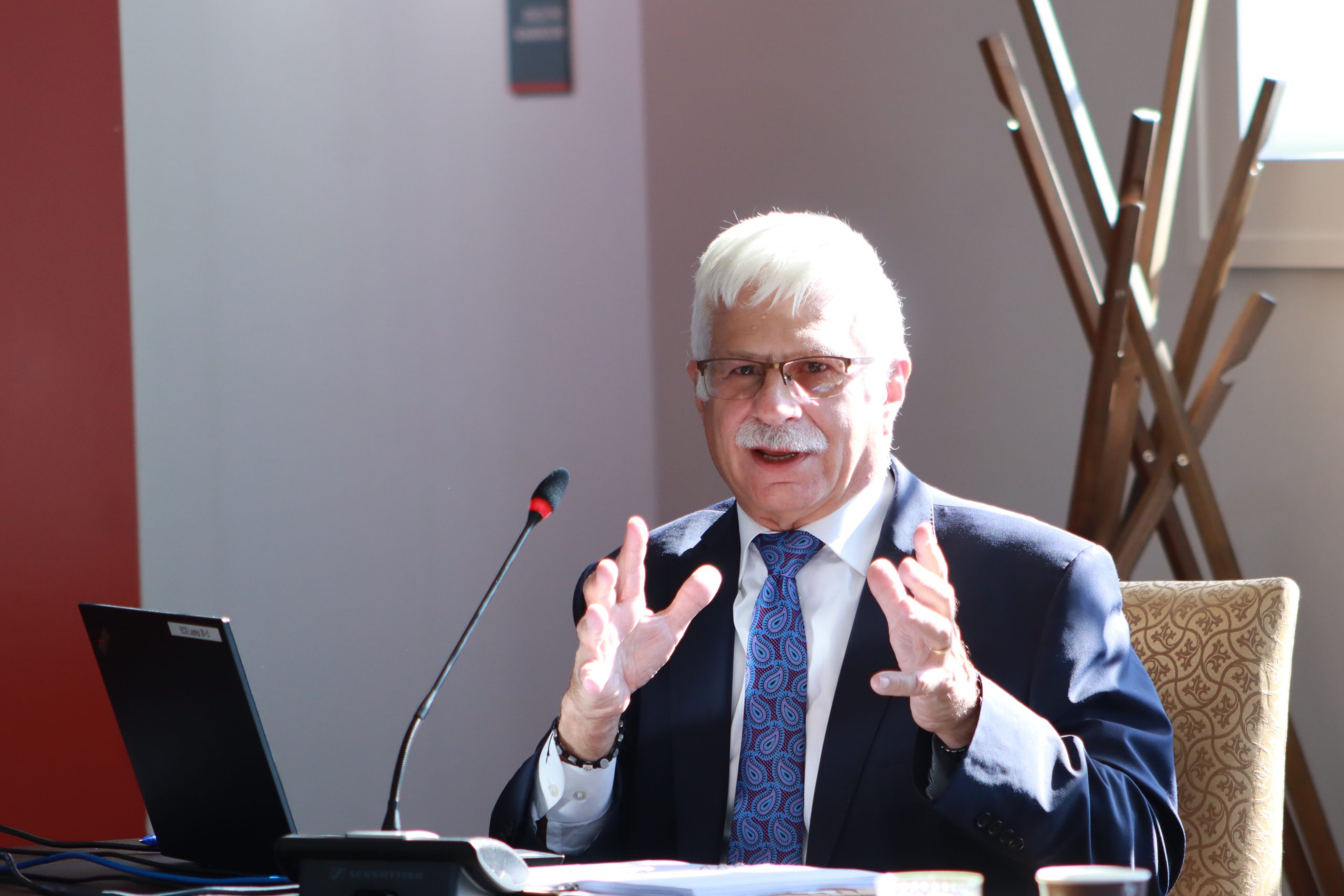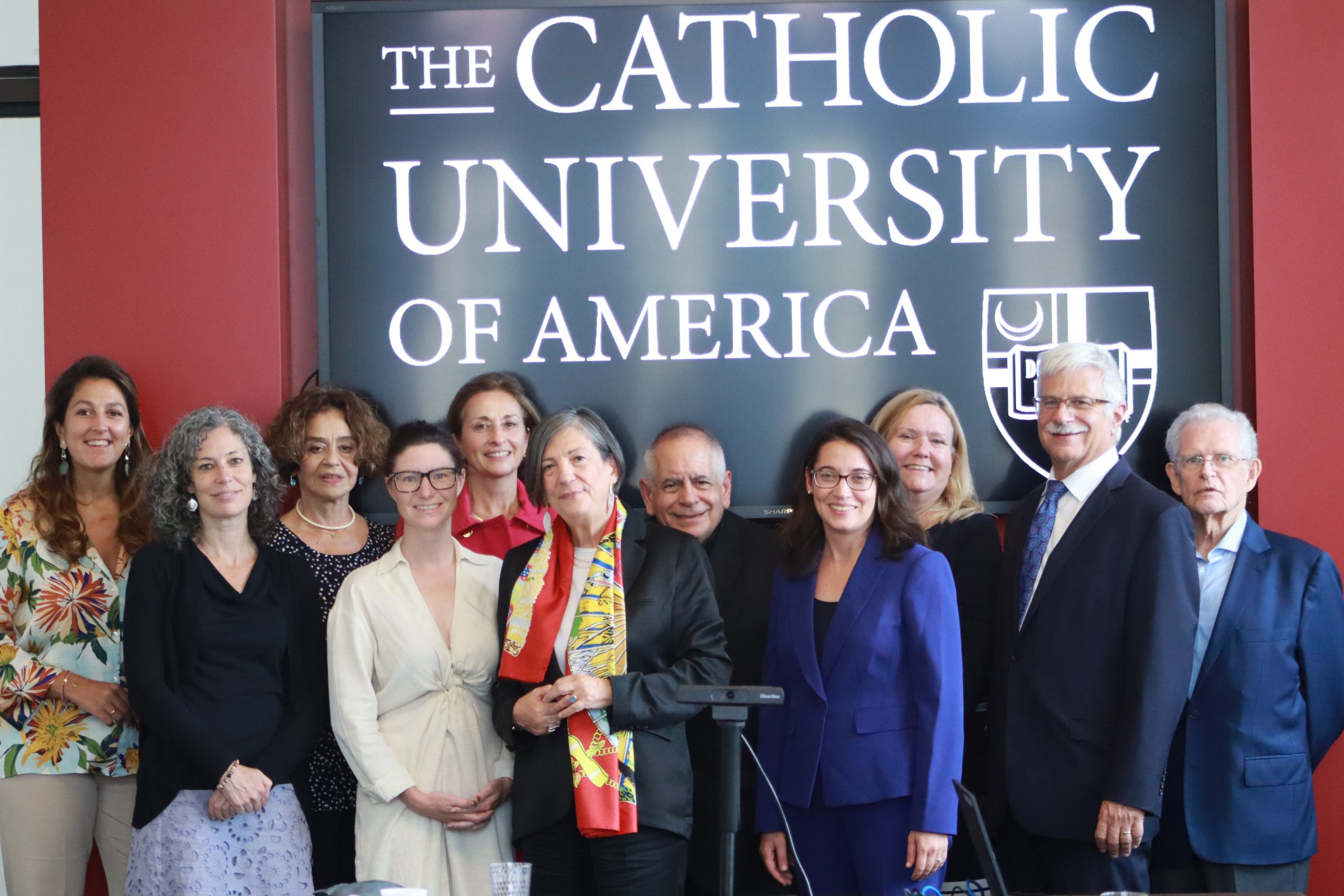Monsignor Robert J. Vitillo – International Catholic Migration Commission
“A Continuing Journey: ‘Care is Work, Work is Care’”
Msgr Robert J. Vitillo opened the meeting with reflections from his long engagement with displaced people, and through the particular lens of the International Catholic Migration Commission (ICMC). Meeting the need for security and stability, and for the dignity of home for migrants is truly a continuing journey. As so many more millions of family lives are disrupted by forced or economic migration, these journeys are becoming longer and more fraught. So too is the journey towards successful interventions and responses by governments both challenging and contested. In a powerful analogy Msgr Vitillo reminded all policymakers in this area that migrants each have their own story and intrinsic dignity and are not “just pieces on the chessboard of humanity.” We need to listen to their voices.
A further illustration drew attention to a sculpture of the exhausted Holy Family in the Washington DC Basilica, a stone’s throw from the meeting room, just as such stories are on our doorsteps today. Msgr Vitillo closed with some of the moving testimonies of those he had worked with, noting especially the hardships parents were prepared to make for a better future for their children. For migrants, family and work are very important. Reminding us again that these are real voices and we have real responsibilities.
Myria Georgiou – London School of Economics and Political Science – LSE
Making a Digital Home? Homeliness at Times of Digital Co- Presences and Absences
Professor Georgiou’s expertise in media communication challenges the static physical notion of home. She argued that we all live increasingly borderless lives facilitated by technology. In this sense migrants are not alone in having multiple connections rather than a single place of home reference. Virtual mobility is a shared phenomenon but the implications of borderless lives impact more negatively on those without the status of “belonging” in their places of often temporary residence. The smartphone allows migrants to organise collectively and to remain in contact with their home context. This is very valuable, but by the same token the loss of a smartphone can be the complete loss of contact and identity. It can also be a means of control and coercion when only those with power over the migrant journey have access to phones.
Drawing on testimonies of migrants who have superficially at least found stability and success in their receiving countries, another strand emerges.
This is the difficulty of integration at a deep level in the face of negative media profiling. The impact of stereotyping migrants as costly and dangerous to the host society is that even when places to live and work are found, people do not feel at home and as one person put it “there can be no dignity outside your own country.” Addressing this pervasive sense – and lived experience – of discrimination will require action by those setting the media message agenda.
Overcoming these obstacles to make meaningful connections needs emotional as well as practical support, and is a long process and the opportunities are uneven. Likewise the digital home requires both a virtual and emotional sense of connection as real home lives are reconstructed.
Kelly Ryan and Heather Salfrank Joseph – U.S. Citizenship and Immigration Services (USCIS)
Building Home in Immigrant Integration and Inclusion Policies and Initiatives
Kelly Ryan contends that all immigration is local, in that strong local community support and interpersonal connections are key to successful immigrant integration and inclusion. The question is how can governments and policies foster the environments needed for these connections and local support systems. Disassociation and isolation are the major risks of failing to make these connections, and this impacts not only migrant experience but also that of the receiving community. The sense of displacement remains even the immediate context is physically secure. The narrative of migration tends to focus on forced migration and vulnerabilities rather than the wider stories of displacement and the strengths and skills of migrants.
The priority is to build a shared sense of social benefit – a “we” culture rather than “them and us.” Full civic participation in American life is known to be key to successful integration. The state cannot regulate human choices but it can ensure that participation is accessible and rewarding. A whole government approach is needed and a good place to start would be an inclusion review such as those conducted by the OECD and outlining a two-way compact between the responsibilities of arriving migrants and those of the receiving communities. The American model of “sink or swim” works best if there can be some swimming lessons – especially in terms of acquiring language skills to engage at every level within the receiving community. Essential services can be provided by state agencies but neighbourliness is also essential to integration and the opportunity to share a meal and the principles of freedom and American values needed to feel truly at home.
Magaly Sánchez – Princeton University
Venezuelan International Migration and how a Welcoming Colombian Migration Policy Fostered Integration into Society
Professor Sanchez began her detailed account of the successful reception and integration of Colombian migrants in Venezuela by noting how important terminology is in the discussion of these issues. The distinction between chosen and forced migration is not binary. Similarly, non-binary are temporary and permanent states of displacement, when many migrants spend decades in refugee camps. The Colombian policy recognises the variety of stories, skills and needs. It is based on generosity and identity but does not deny the challenges to generosity by the receiving communities in the face of such a diversity of world views/culture/politics/economic status – bearing in mind that 97% of Venezuelans live in extreme poverty.
Shared language is a great aid to integration and in re-establishing a sense of home in a new homeland. Sharing housing has also proved effective and well-received by both Colombian hosts and Venezuelan migrants. Many activities relate to household chores and sharing this work has been good for integration. The high proportion of younger migrants has been seen as a demographic bonus and as a contribution to Colombian society. The equally high-proportion of self-employed migrants also indicates a determination to contribute to the livelihood of their shared new home.
Robert Destro – The Catholic University of America
The Concept of ‘Home’ in Human Rights Discourse* with Special Reference to the Needs of Displaced People
Professor Destro spoke with reference to his considerable experience as a lawyer working within this field, but recognised that finding definitions in such a complex area can mean missing the human point of view. Experiences of displacement from homeland have personal as well as geo-political ramifications as we are seeing so vividly in the Ukraine. Professor Destro outlined his recent experience of migration in the context of Nigeria and the many factors making internal displacement such a problem for both people and government.
It is important to consider migration not only from the migrant point of view but also from the received point of view. Developing from this is the whole question of what constitutes a welcoming receiving community as well as the best migrant disposition. It is seen best in terms of relationships. When you are at home you are not a guest. You have responsibilities to the household as well as the benefits of being at home. Treating migrants as permanent guests does not lead to integration. There are many barriers to this integration including negative stories of migrant settlement, but recognising the local factors is vital. Subsidiarity means allowing the “bottom-up” work of host communities to be supported, but not controlled, by the “top-down” mechanisms of the larger state.
Suzan Ilcan – University of Waterloo
Reflecting on Displacement and Resettlement: Experiences of Leaving Syria, Memories of Home, and Remaking Home in Canada
This chapter considers the recollections of people on the move who have survived the current Syrian war and confronted the challenges of forced displacement, relocation, and remaking home, areas which have received moderately little academic attention. In building upon the insights of Syrians’ experiences of forced displacement, the chapter focuses the analysis on their migrant journeys during displacement and their remaking home during resettlement in Ontario, Canada. These journeys are part of the broader tensions between displacement and resettlement, which contribute to their experiences and the challenges of remaking home in Ontario, Canada.
The concept of home in migration studies is commonly viewed through notions of territory, nation-states, and borders, which in turn have created dichotomies of “here” and “there” between the host country and home country (e.g., Boccagni 2017a; Taylor 2013). Furthermore, a plethora of research on home tends to emphasize Western-middle class experiences, including a focus on the distinction between private and public domains of home, where the former is understood as a safe haven and the latter as a place of interactions with strangers (Boccagni and Brighenti 2017). Recent scholarship on home is paying greater attention to its diverse meanings, including those that exceed the view of home as tied to a fixed place. It is increasingly emphasizing how family, friends, and community relations contribute to multiple meanings of home (see den Boer 2015). In this regard, conceptions of home are not immobile but dynamic processes involving acts of envisaging, producing, unmaking, changing, losing, and remaking home. This chapter contributes to this scholarship by highlighting these and other similar dynamics. It pays particular attention to issues of displacement and resettlement of Syrians, which it investigates along four levels: (a) the migratory journeys out of Syria to nearby host states; (b) memories of home in Syria; (c) state policies that aim at protecting refugees while at the same time imposing restrictions on everyday lives; and, (c) remaking home in Ontario, Canada that comprise complex relations that are embedded in diverse experiences of belonging. The theoretical and empirical arguments draw on scholarly, policy, and media materials, and on twenty in-depth, qualitative interviews with displaced people from Syria who have relocated to London and Windsor, Ontario, Canada.
This paper is based on extensive scholarly, policy, and qualitative, semi- structured interviews. A total of twenty formal interviews were carried out with people who had left Syria during the conflict. These interviews took place in London and Windsor, Canada. Ten interviews were carried out in London, Canada with a total of thirteen participants in 2019, and ten interviews were carried out in Windsor in 2018. All interviews were conducted in person and in the Arabic language, though discussions in English occurred with some research participants. Twelve Syrian women and eleven men were interviewed, all of whom have been resettled in London and Windsor within the past nine years. At the time of the interview process, most participants held permanent residence status, while a few held Canadian citizenship status. Of all sponsored refugees, approximately seventy percent of them were government-sponsored and the remainder were privately sponsored. All research participants lived in Syria during and prior to the war and left Syria to nearby host states, including Egypt, Jordan, Lebanon, and Turkey, between 2012- 2017. They experienced various forms of insecurity (e.g., regarding rights, mobility, employment, residence) while living in Syria and in nearby host states. In the interviews, participants highlighted their lived experiences during the civil conflict, decisions to relocate within Syria and to neighbouring countries, memories of home in Syria, and processes of remaking home in London and Windsor. The interviews conducted in the two cities were digitally recorded with the participant’s consent and transcribed in full prior to being analysed. To protect their identity, all names of research participants in this chapter are pseudonyms.
Christine Mahoney and John Kluge – University of Virginia / Refugee Investment Network
Investing for Inclusion: How Refugee Lens Investing can Facilitate the Inclusion of the Forcibly Displaced into Local Host Communities
Professor Mahoney shared her 15 years’ experience of thinking about how we can more effectively advocate for the lives of the displaced. At every level in her fieldwork it was incredibly difficult to advocate for the right to work, the right to start a business, the right to open a bank account, the right to take a micro loan for people held in the limbo of displacement – often for decades. From this experience she argued for a new strategy, where concerned global citizens could directly improve the lives of the displaced by micro microfinance funds, and impact investing funds. This was a response to what was observed: that migrants are entrepreneurial and that despite all that many had lost they retained their desire to run the businesses and create the livelihoods of their former homes. The Refugee Investment Network (RIN) set up by Professor Mahoney and her husband John Kluge makes these businesses possible. The range of investment relationships from Refugee Owned to Host- Weighted schemes was outlined. Unlocking capital in the service of the displaced allows for the scaling up of programmes that are beyond the reach of the charity sector.
Current work in Mexico is a strong model for this where south to north migration is being managed to improve access to residency and economic engagement with the host community. The impact investing scene in Mexico is alive and growing and Professor Mahoney detailed some of the businesses involved. This approach is still at the developmental stage but is already seeing real benefits for all concerned – including investors.
Sandra Barrueco and John Paul Ryan – Catholic University of America
Home Life and Familial Experiences of Migrant and Seasonal Farm Workers in the United States: Results from a Nationally Representative Study
JP Ryan began with a literature review on the concept of home and feeling at home for migrants. Strong relational association – where family is there is home. Intact family structures lead to more settled experiences even when physical circumstances are unstable. Religion is a major cultural aspect of the home and being able to continue these traditions strengthens identity and the ability to make a new setting feel like home. The psychological costs of living as a displaced person have not received the investigation they deserve, but poor housing, multiple jobs and feeling unwelcome all contribute to depression and anxiety. The stress of displacement should be considered, especially the trauma of forced migration, but so too should the benefits of finding a new place to thrive including resilience, adaptability and entrepreneurship.
Professor Barrueco drew upon 20 years of research on the Migrant Farmworkers Study of people “living in the shadows and working in the sun.” The key findings on home and family life reveal the poor housing choices available to such workers as they try to maintain family cohesion while working on the land. Provision for children is considered a benefit of this form of work and the hope that children will have US citizenship and better life experience. Hope is generally a key motivation for workers. Questions of resident status and freedom to return are very vexed as this is a moving population, going from job to job and harvest to harvest. Professor Barrueco has available policy and research briefs on governmental actions to improve the conditions and status of these key workers.
